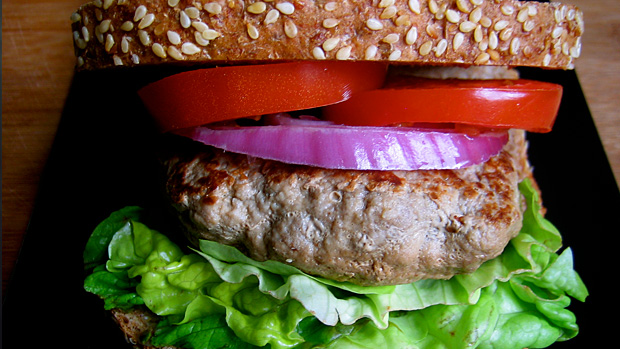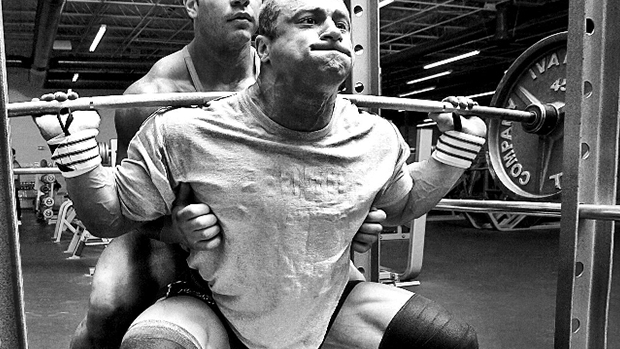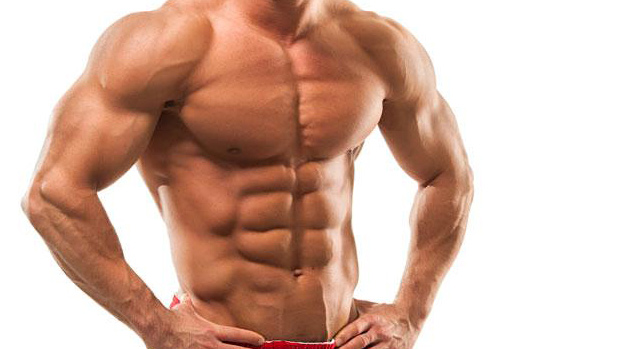Now that I know how much to eat, what's next?
Eating to get massive is a juggling act between three important concepts. As I stated in Part 1, energy balance is only one. In focusing only on energy balance, individuals are ignoring the acute effects of eating on hormones, metabolism, and energy storage. So someone who argues that calorie balance is the only determinant in changing body composition is making the situation too simplistic.
One of the goals of eating to grow should be to maximize the muscle gain to fat gain ratio. Basically you want to pack on the most muscle with the least amount of fat gain. To do this you need to understand which meal combos to pursue and which to avoid. The foundations of my recommendations in this area are based on the avoidance of a nasty scenario. The worst case scenario for someone trying to pack on muscle while minimizing fat gain is to have high blood levels of carbs, fat, and insulin at the same time.
This is nasty because chronic elevation of insulin can increase the rate of transport of fats and carbs into fat cells. Although initially insulin shuttles nutrients into muscle cells, chronic insulin elevation will cause the muscles to become insulin resistant and refuse to take up nutrients. The adipose tissues, however, are greedy little pieces of cellular machinery and continue to take up nutrients at a rapid rate. So if you always have high levels of blood fats and carbs in the presence of insulin (the kind your body makes, not the kind that comes in a syringe), your muscles will slow their uptake of nutrients and all that fat and carbs will feed the fat cells. Can you say Shamu?
Before you make a rash decision and try to eliminate insulin, I've got to let you know that insulin is very anabolic. It's responsible for carb and amino acid delivery to the muscles for recovery and growth. So you need insulin, but you need to control it. And when you eat to promote insulin surges, you've got to be sure that you have the ideal profile of macronutrients in your blood to ensure that this insulin surge leads to muscle gain and not fat gain. This is where meal combinations come into play.
Let's start with some meal combinations to avoid.
Unfortunately, this is the typical meal of the Western diet. As a result, it's no wonder that obesity is an epidemic. Meals with a high carbohydrate content in combination with high-fat meals can actually promote a synergistic insulin release when compared to the two alone. High fat with high-carb meals represent the worst possible case scenario.
Now, some people have argued that fat lowers the glycemic index of foods and should therefore be included in carb meals. But remember, the glycemic index only gives a measure of glucose response to a meal, not insulin response. And sometimes the glucose responses to a meal and the insulin responses to a meal aren't well correlated. So although you might be slowing the rate of glucose absorption into the blood by adding fat to your meals, you'll promote high blood levels of fats, carbs, and insulin. And that's a no-no!
Ironically, since the liver converts excess carbohydrates into fats, a very high carbohydrate meal can actually lead to a blood profile that looks like you just ate a high carb and high-fat meal! That's why high-carb diets don't work any better than ones rich in fats and carbs. High carb meals easily promote high blood levels of fats, carbs, and insulin, too.
Okay, so now that we know which meal combinations are evil. Let's be proactive and talk about what meal combinations to concentrate on.
It's well known in the research world that eating carbs and protein together also creates a synergistic insulin release (much like the fat and carb meals above). But in this scenario, that insulin release is just what we want. By having a few meals per day that cause high blood levels of insulin, carbs, and amino acids (as long you don't have chronic high blood levels of insulin all day long), the body tends to become very anabolic, taking up all those carbs and amino acids into the muscle cells for protein and glycogen synthesis. And since there's no excess fat for the fat cells, fat gain is minimized.
Obviously this combination is beneficial during the post-workout period, but in addition you might want one or two additional insulin spikes per day to promote anabolism during a mass phase. Again, as long as you aren't elevating insulin all day long, you won't become insulin resistant.
At this point some may argue that although this scenario might not promote fat gain, those high insulin levels will prevent fat breakdown (lipolysis). And they're completely correct! But you have to understand that most meals (unless they contain only certain types of protein) will elevate insulin levels to the point that lipolysis is prevented. So you can't escape that unless you eat a ketogenic diet with only specific types of low insulin releasing proteins. But since ketogenic diets don't put on muscle mass and there are all sorts of problems associated with them, I think they should be avoided. Since muscle gain is the goal, two or three meals per day of anabolism are necessary to get bigger and that means protein plus carbs with minimal to no fat.
Although it's desirable to eat some meals each day that release lots of insulin, upregulate protein synthesis, and fill up carb stores, it's advisable to avoid too many such meals. I discussed the reasons for this above (reduced insulin sensitivity and prevention of fat burning), but also, since we all know that essential fatty acids are so important to health and favorable body composition, eating protein and carb meals all day will prevent the ingestion of healthy fats. And that's no good.
In an attempt to balance out your two or three carb plus protein (minimal fat) meals each day, you should be eating an additional two to three meals consisting of protein and fat with minimal carbs. Taking in 30% of each major class of fatty acids (polyunsaturates, monounsaturates, saturates) is a good mass building tip when thinking about which fats to consume.
Taking a step back, the purpose of protein plus fat meals is to provide energy and amino acids without causing large, lipolysis-preventing insulin spikes. In addition, after fatty meals that contain no carbs, the body oxidizes less carbs (more carbs are stored and retained in the muscle as glycogen) and burns more fat for energy. So basically you'll be burning fat for energy and storing carbs in the muscle after such meals.
I hope that it's clear now that by properly combining meals, you can use the acute effects of food to your advantage. Eat protein plus fat during some meals and you may be burning fat during certain portions of the day. Eat protein plus carbs for some meals and you may be growing during other portions of the day. Although I know some will think this is blasphemy, this type of eating may actually help you get bigger while reducing your body fat during the same training phase.
Don't you hate it when you read a diet article only to find yourself asking, "So what exactly do I eat anyway?" Well, here are some examples of typical meals to consume when following this program:
Protein plus carb meals (minimal fat – <5g)
- 2 scoops of protein powder mixed in with 1 serving of oatmeal
- 1 sliced banana
- 1 cup of regular or lactose free skim milk
- 1 serving Metabolic Drive® Protein
- 1 can tuna fish
- 1 cup of regular or lactose free skim milk
- 2 pieces of whole grain bread
- Vegetables
- 8 egg whites
- 1 scoop of protein in 1 serving of oatmeal
- 1 slice of whole grain bread
- 1 piece of fat free cheese
- Vegetables
- 2 cups of regular or lactose free skim milk
- 1 scoop protein
- 2 pieces of fruit
Here's a list of good carbs and protein for the protein plus carbohydrate meals:
- Carbs: apples, oranges, oatmeal, all bran cereals, vegetables, mueslix, white pasta, flax bread, yams
- Protein: chicken, whey, casein, turkey, egg whites, skim milk, tuna, cottage cheese
Protein plus fat meals (minimal carbs – <10g)
- 1 can salmon
- 1 scoop protein powder in water
- Vegetables
- 1 tablespoon of concentrated fish oils
- 8-12 oz lean beef
- Fat free cheese
- 1 tablespoon of olive oil
- Vegetables
- 1 can tuna fish
- 1 scoop protein powder
- Vegetables
- 1 tablespoon of concentrated fish oils
- 2 scoops protein powder in water
- 1 tablespoon flax oil
Here's a list of good fats and proteins for the protein plus fat meals:
- Fats: Concentrated fish oils (PUFA-omega 3), flaxseed oil (PUFA-omega 3 and 6), olive oil (MUFA), canola oil (MUFA and PUFA), fat from nuts (MUFA and PUFA), fat from beef and eggs, animal fat (SFA)
- Proteins: beef, salmon, whey, casein, turkey, whole eggs, pork
In the last section I recommended splitting six daily meals up into about three protein and carb meals and about three protein and fat meals. This plan works well for most people in terms of maximizing muscle gain while minimizing fat gain when overfeeding. However, just like different training programs are necessary for different individuals, individual responses to nutrition are varied. So rather than telling you that there's one program for all, I hope to give you some tips so that you can determine which eating plan is best for you.
The factors governing your response to different nutritional intakes are pretty diverse, but one major factor I've been focusing on lately is insulin and glucose tolerance. In my mind, insulin sensitivity seems to be the most important factor dictating how the body will handle carbs. For those who have high insulin sensitivity, the body responds to carb intake with small insulin surges. Although the insulin surges are small, the cells are very responsive to that little amount of insulin and do a great job of becoming anabolic. Since lots of insulin can inhibit fat loss, the ideal scenario is to become very insulin sensitive so that only small amounts of insulin are required for anabolism and so that those small amounts of insulin don't prevent fat loss.
In my experience, individuals who have high insulin sensitivity maximize their muscle to fat ratio on diets that are high in carbs and lower in fat (50% carbs, 35% protein, 15% fat). Those with moderate insulin sensitivity tend to do best on diets that are more isocaloric (30% carbs, 40% protein, 30% fat). And those with poor insulin sensitivity do best on diets that are low in carbs (50% protein, 35% fat, 15% carbs).
So within the framework of this article, if you're highly insulin sensitive, more than three of your daily meals would be carb plus protein meals. If your insulin sensitivity isn't so great, more than three of your meals will be protein plus fat.
So the next question is how do you know if you're sensitive or not? Did you cry at the end of Titanic when Leonardo DiCaprio's character sank like a blue Freezer Pop into the North Atlantic? Well, there you go; you're sensitive. Me? I cried like a baby. Okay, okay, actually there are several methods.
The easiest thing to do is just think about what types of diets you respond to best. If low carb diets work great for you, then you're probably insulin insensitive. If you can eat a lot of carbs and not get fat then you're probably insulin sensitive. If you'd like something more concrete than that, read on.
Some experts use very simplistic recommendations for testing insulin sensitivity, methods I disagree with. For example, I've heard the statement that if you have an apple-shaped physique or if you get sleepy after a carb meal then you're insulin resistant (insensitive). In my opinion, these are way too non-specific and tell you very little about your nutrient needs or if you're making progress.
Instead, I prefer methods that, although more time consuming, are objective. The first is an oral glucose tolerance test. For this you need to go to your local pharmacy and purchase a glucometer, some glucose test strips, and a standard glucose beverage (ask your pharmacist about this because it has to be a specific kind. Pepsi won't work). Once you've got the goods, you'll plan your test.
After going at least 24 hours without exercise (do this test after a day off from training), you'll wake up in the morning (fasted at least 12 hours) and you'll take a blood sample from your finger tip. Write down this number. Then drink your glucose beverage and continue to take blood samples at 15, 30, 60, 90, and 120 minutes. Record all the numbers at each time point. Here's a little chart of what you should expect:
Insulin Sensitivity and Glucose Tolerance
| Normal | Excellent | |
|---|---|---|
| Fasted Blood Glucose | <100mg/dl | <70mg/dl |
| Peak Blood Glucose | <180mg/dl at peak | <130mg/dl |
| Time to Maximum Blood Glucose Level | 30-60 minutes | 15-30 minutes |
| Time Back to Fasted Glucose Level | 30-60 minutes | 60-90 minutes |
The second test that I like to recommend for assessing insulin sensitivity is a fasted glucose and insulin test. For this you need to see your doctor. This test is simply a blood draw in the fasted state. It's easy to do. Just schedule an appointment, the nurse will do a single blood draw, and then the lab will measure the levels of insulin and glucose in your blood at this time. Using one of the following equations, you'll have both an insulin sensitivity score and a pancreatic responsiveness score:
Insulin Sensitivity =
- Fasted Insulin (mU/L) / 22.5 x E to the X e-ln(Fasted Glucose (mmol/L))
- or
- Fasted Insulin (pmol/L) x (Fasted Glucose (mmol/L) / 135)
Pancreatic Beta Cell Function =
- (20 x Fasted Insulin (mU/L)) / (Fasted Glucose (mmol/L)-3.5)
- or
- (3.33 x Fasted Insulin (pmol/L) / (Fasted Glucose (mmol/L)-3.5)
If you're not a math whiz or don't own a calculator, have your doctor do the math for you. Remember, you have to go to his office to get the test done in the first place. Once you have these values, compare your numbers to the following to see how sensitive you are:
Insulin Sensitivity
- Lower score = more sensitive
- Normal insulin sensitivity: score should be below 2
- Excellent insulin sensitivity: score will be around 0.5
Pancreatic Beta Cell Function
- Higher = better pancreatic function and insulin release
- Normal pancreatic function: score should be about 100
- Excellent pancreatic function: score will be above 200
Once you've collected these measures, you'll have a better indication of what type of diet you need to consume. I recommend doing these tests at least once every few months to see how your diet and training is impacting your insulin sensitivity.
So let's assume that you've done the tests mentioned above and you weren't happy with the results. You're insulin insensitive and, dammit, you don't like it! Well, instead of resigning yourself to a flabby midsection for the remainder of your days there are some things you can do to increase insulin sensitivity.
Both aerobic and resistance training greatly increase insulin sensitivity through a variety of mechanisms. So include both in your program. I've seen tremendous increases in insulin sensitivity with three to four intense weight training sessions per week lasting 1 to 1.5 hours per session. These sessions should be coupled with at least three or four aerobic sessions lasting 30 minutes per session. To really target insulin sensitivity, you'd want to perform weight training and cardio separately.
In addition, supplements like omega 3 fatty acids, fish oils, alpha-lipoic acid, and chromium can increase insulin sensitivity. I typically recommend starting out with 600 mg of alpha-lipoic acid (ALA) and concentrated fish oils containing a total of six to ten grams of DHA and EPA (the most active omega 3 fats in fish oils).
On the flip side, stimulants like ephedrine and caffeine can decrease insulin sensitivity due to their effects on metabolism. Furthermore, the low carb, high-fat diets that have become popular can also lead to decreased insulin sensitivity. That's why my trainees don't take stimulants or go on no-carb diets (unless they're dieting down for a show and then they'll do occasional no-carb diets every few months for a maximum of three weeks at a time).
So if your insulin sensitivity isn't ideal the first time you measure it, try the approaches I listed above. Then go back after a month or two and re-test. You'll see that the numbers look much better.
Even though the last section will help you better define where you stand with the insulin issue, probably the most productive way of determining which eating program is best for you is to experiment on yourself. So for eight weeks, I encourage you to follow a 50% carb, 25% protein, and 15% fat diet that exceeds your energy needs (as determined in Part I of this article). During this time, record your gains in terms of muscle mass and fat mass. This will give you a muscle:fat ratio.
Then go back to your normal eating for eight weeks. After those eight weeks, try a new diet of 30% carbs, 40% protein, and 30% fat for eight more weeks. Again record the muscle:fat ratio.
After these 24 weeks you should know which type of diet is more effective for your body type. I know it seems like quite a bit of time to devote to figuring out your eating needs, but assuming that you've been training for years or plan to be training for years to come, 24 weeks is only a small period of time. In addition, the results of your efforts will be applicable for the rest of your life.
Remember, however, that when constructing your eating plan you must realize that just because you're following a diet with 50% carbs, 25% protein, and 15% fat or a diet 30% carbs, 40% protein, and 30% fat, that doesn't mean that each meal is made up of these proportions. In fact, the meals should not all be of these proportions because this will mean undesirable blood levels of fat, carbs, and insulin. So using the techniques I taught you during the meal combination section, design a plan that has different proportions of macronutrients during different meal times but that achieves the optimal proportions of (40-30-30 or 50-25-15) by the end of the day.
Here's a quick and dirty summary of the Massive Eating plan:
- Read Part 1 and determine your daily caloric needs.
- Eat meals consisting of fat and protein together with very little carbs. Also eat protein and carbs together, but with very little fat in those meals. Don't eat carbs by themselves and don't eat carbs with fat.
- Determine your macronutrient ratios based on your level of insulin sensitivity. You can do this with the tests I explained or you can just try different diets consisting of different rations of protein, carbs and fat. If you're insulin insensitive you can do something about it by following my suggestions above.
Remember, if you aren't putting on muscle while following a good weight training program, then it's probably your diet that's to blame. With Massive Eating, your problem is solved, so no more excuses! If you ever find yourself making statements about your genetic limitations or your unreasonably fast metabolism, revisit these articles for a wake up call. "Limitations" can become challenges to work through or just weak excuses that keep you down.
Now, shouldn't you go get something to eat?




